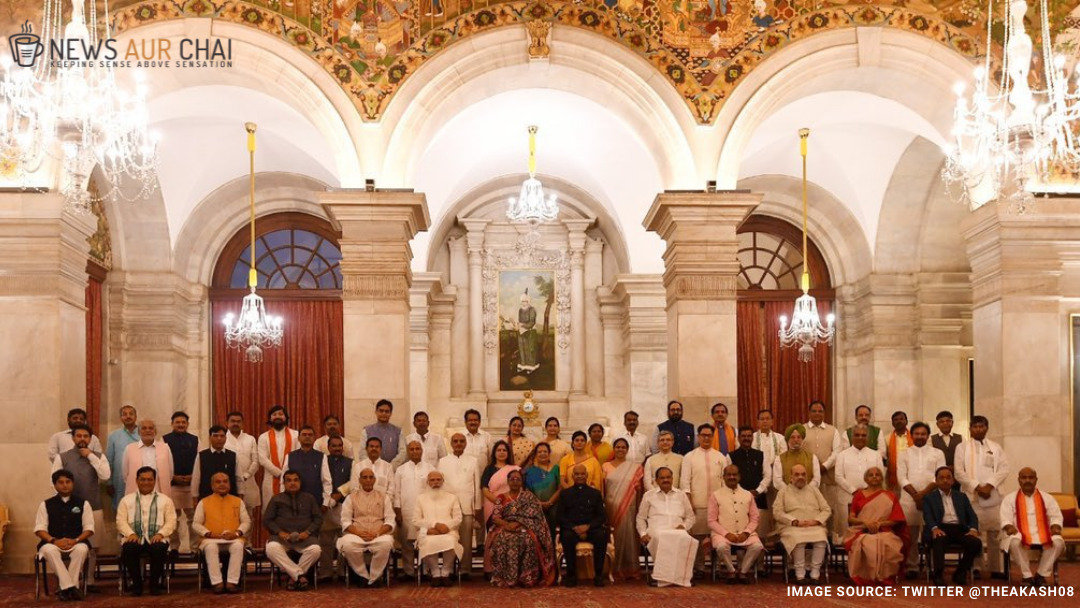
On the 7th of July, the union government announced the biggest cabinet expansion in the 7 years of NDA rule. The recent expansion increased the size of the Council of Ministers from 53 to 77. About 43 new ministers were sworn in, 15 of which were Cabinet Ministers and 28 Ministers of State (MoS). This is the first cabinet overhaul in the second term of NDA governance.
Experts however claim that the new cabinet expansion is a pre-emptive measure to balance electoral formulae in different states ahead of the 2022 State Assembly elections. It is also conjectured that the reshuffle comes as rectification of prolonged criticism about BJP’s governance in the past 2 years, including the Healthcare management during the Pandemic.
The Performance Paradox
This recent cabinet expansion is a report card of the BJP government’s performance in the last 2 years. Major ministerial changes, such as the resignation and replacement of Dr. Harshvardhan as the Health Minister indicate a confession of their mismanagement of the pandemic.
He has been replaced by Mansukh Mandaviya, a 2 time Rajya Sabha MP who has also been awarded by the UN for initiatives in Women’s healthcare in the past. His appointment as the Health Minister is one of hope for BJP, to change and streamline (a.) the COVID-19 Pandemic response and (b.) BJP’s image in the name of healthcare management.
On the contrary, Anurag Thakur’s promotion from MoS Finance to a Cabinet Minister defies all logical explanations for awarding performance. Not only has India’s economic condition worsened under his management, his controversial statements like “Desh ke Gadaaro ko…” do not present a strong case for him. His appointment is a political investment by BJP in Himachal Pradesh’s state elections next year which happens to be Thakur’s home state.
Similarly, Sitharaman’s finance ministry has remained untouched, after historical mismanagement of our Finance capabilities. All of this reflects a selective approach adopted by BJP, which is one of political hesitation and hyperopic ignorance.
BJP’s Political Calculator
Apart from the ‘punishment’ narrative, the new cabinet expansion has also given an insight into BJP’s political planning. This expansion has incorporated key leaders from several states that go to elections next year. Moreover, it has also been carefully planned to cover the losses BJP has incurred in the past two years.
As a reward for dismantling the elected Madhya Pradesh government and tipping scales in BJP’s favor, Jyotiraditya Scindia was appointed as the Cabinet Minister for Civil Aviation (a post held by his father as well in ’91) almost after 3 years.
On the contrary, Pashupati Kumar Paras got an early reward for breaking down Lok Janshakti Party’s (LJP) representation in Lok Sabha. He was appointed as the Union Minister for Food Processing, after the attempted coup on Chirag Paswan’s leadership.
Sarbananda Sonowal, who was replaced by Himanta Biswa Sharma as the Chief Minister of Assam after the fresh elections, was also awarded a berth in the Cabinet. It is conjectured that this development was in talks ever since Himanta Biswa Sharma was chosen as the CM.
As the Uttar Pradesh elections near, BJP also made sure to improve representation from the state. Major appointments such as Niranjan Jyoti (MoS Food Processing), Anupriya Patel (Mos Commerce and Industry), and Bhanu Pratap Singh Verma (MoS MSME) were made majorly because of their heavy support base in UP.
Following the same lead, Ajay Bhatt from Uttarakhand was appointed as MoS Defence and Tourism. As seen earlier, BJP has made major organizational changes in Uttarakhand which goes to elections next year.
Some Positives
In the mirage of calculated placements and image reconstruction, BJP has hit a few rights with this organizational change. The new cabinet includes a maximum number of women to have ever served in a Union Cabinet, a first in a nation with largely patriarchal tendencies.
The cabinet has also tried to focus on bringing people with commendable background experience and education on board. Ashwini Vaishnav, former IAS and an alumnus of Wharton School have been given major ministries such as Railways, Communications, and IT. Similarly, Anupriya Patel who has been given the Commerce and Industry as an MoS has also served as an educator at Amity University.
Moreover, the diffused reliance on regional strength has become the overarching theme in this cabinet reshuffle. Even though the ruling party intends to balance the voter dynamics, this regional unity has become something to watch out for.
Yet, the big story remains the ouster of major politicians who have served loyally and faithfully to this government. Ravi Shankar Prasad, Prakash Jaavedkar, and Dr. Harshvardhan are major losers in this dynamic reshuffle. While the current government has tried to modernize the leaders of this nation, it has set a new precedent that loyalty is not the most critical virtue anymore; Election Commission’s schedule is.






2 Comments